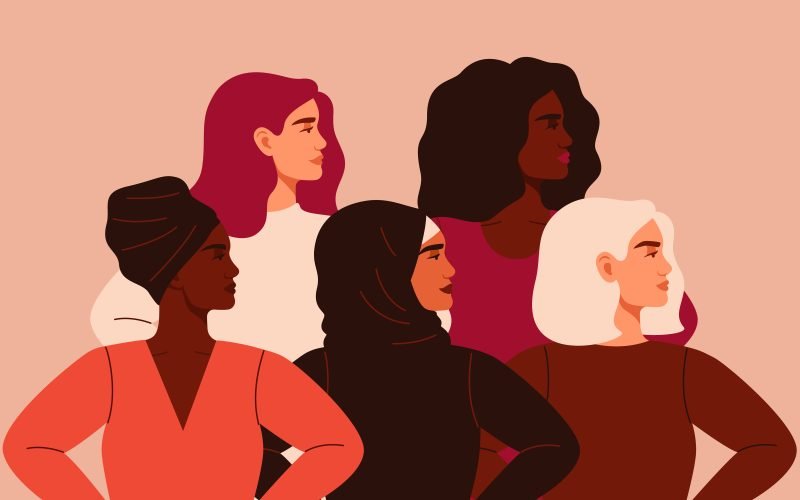Editor’s Note: FII’s #MoodOfTheMonth for January 2023 is Gender And Journalism. We invite submissions on this theme throughout the month. If you would like to contribute, kindly refer to our submission guidelines and email your articles to shahinda@feminisminindia.com
I study mass media and communications in India, and my class is made up mostly of women. But the data shows that when I and my peers enter the industry, we will be entering a workplace that is conspicuously male. Journalism, by far and large, has always been dominated by men. What is new is the sudden and abrupt drop in female participation between 2015 and 2020. So perhaps my classmates and I will not be able to enter the journalism industry at all. If we do, we might take the pipeline into celebrity and gossip news, or the soft beats like healthcare and education. Where does that leave us as a society? Who will we be without the female perspective in our reporting?
The pandemic and the economic upheaval after that has completely decimated the female presence in journalism. Women now form 52% of TV news reporters, 20% of radio newscasters, and 13% of print reporters in India. These figures are already low compared to figures from the overall Asian continent: 55% in TV, 42% in radio, and 31% in print.

The 2020 edition of the Global Media Monitoring Project’s (GMMP) Who Makes The News report was clear and succinct. Women in journalism – both as subjects and as mediums – are going extinct in India. With a clear focus on women as reporters and journalists, and the sharp decline of their participation in the industry in 2020, it is high time to take a dive into the data this report gives us.
Less than 50 percent
Women might be 50% of the population, but that is certainly not true for the journalism sector. One might rather dubiously have claimed that men and women were represented equally in newsrooms in 2015 – 60% of TV reporters and 43% of print reporters. However, even this claim cannot reasonably be called true after considering 2020 data. The pandemic and the economic upheaval after that has completely decimated the female presence in journalism. Women now form 52% of TV news reporters, 20% of radio newscasters, and 13% of print reporters in India. These figures are already low compared to figures from the overall Asian continent: 55% in TV, 42% in radio, and 31% in print.
The cause for this overwhelming decrease can be explained by the increased need for domestic labour during the pandemic, a job that is relegated to women. In a year where schools were closed and migrant domestic labour was retreating to rural areas due to the economic crash, households were simply unable to afford childcare and the domestic labour that came with it.
The Global Media Monitoring Survey does not mention any causation for its results. However, these can be interpreted from the general trends in the economy in 2020. In terms of female participation, it is evident that the decrease in female participation in the journalism sector is simply a part of the decrease in female participation in the economy in general. This was the year when jobs were cut and people were forced to stay home, and women were the first to receive the blunt end of the hammer. World Bank data showed that the percentage of women working in India in general decreased from 26% to 19%.

The cause for this overwhelming decrease can be explained by the increased need for domestic labour during the pandemic, a job that is relegated to women. In a year where schools were closed and migrant domestic labour was retreating to rural areas due to the economic crash, households were simply unable to afford childcare and the domestic labour that came with it. When the time came for families to make up for this household labour, women were first on the chopping block. More girls were married off at a young age, and working women were forced to leave their jobs in order to care for their newly unoccupied children. With a cultural aversion to household labour, men chose to let their wives and daughters sacrifice their careers, leading to the trends we see today.
Beat down
The devil is in the details. Women are not disappearing evenly in the industry. Digging deeper into the numbers, this gap materialises in the beats allocated to male and female journalists. Here’s what the data says. All topics were covered overwhelmingly by male reporters, both in 2015 and in 2020. Yet, in 2020, there was almost a negligible number of reporters in the Celebrity, Arts, Media and Sports category, Gender category, and Crime and Violence category, all covered exclusively by men.
Also read: Cyber harassment, Trolls, And Cancel Culture: A Lingering Threat To Women And Queer In Journalism
Again, the GMMP report does not claim any causation. However, a 2022 article in the Times of India by independent journalist Kalpana Sharma sheds some light on women in the journalism sector. “Even if the news organisations do not discriminate against the women they employ, there are subtle ways in which women continue to be pushed into certain beats… Some women choose these beats. Others are left feeling that they were never given a choice.”

The persistent belief that women are simply incapable of understanding male-dominated sectors such as business, economy, and politics has resulted in the female perspective being almost completely deleted from journalism, meaning that women are often not given a voice in journalism at all.
There is a fair proportion of results which solely revolve around the anchors’ looks, instead of any of their content. “Top 10 most beautiful journalists in India”, writes top10about.com. This sexualisation of women on television, even in their professional roles, speaks to our tendency to objectify women regardless of their intent, refusing to give these women the respect they deserve.
Giving another face to this debate, Sharma states that women being prominent in the health beat proved particularly useful during the COVID-19 pandemic, where some of the most stellar journalism was produced by women. “They already had background knowledge on public health, disease, the pharmaceutical industry, all essential for effective coverage in these dire times.” Yet, she warns against using these prominent women as evidence that there is no sexism in the industry. Class, caste, and gender all intersect in a way to make journalism an uneven playing field for women seeking to excel.
The TV effect
Without a doubt, detractors point to the prevalence of female reporters in TV news as a sign of gender equality finally being achieved in the Indian media landscape. Initially, the data does seem to support this claim. Women are 52% of the room in 2020. What explains this large percentage? Have women truly achieved equality in TV journalism? The GMMP report suggests otherwise. As a footnote, they state, “The preference for women in a younger age group in visual media like TV could be hidden sexism at work, reinforcing the notions of glamour and fashion, and attractive young women drawing audiences based on their looks rather than the content of the news.”

This analysis is also reflected in the strict beauty norms for female journalists worldwide. A study by the University of Texas in 2018 found that on average, women in TV journalism tended to be more attractive, better groomed, and younger than male reporters. Even then, beauty standards tended to skew towards the dominant Caucasian beauty standards, with Hispanic and African-American reporters having lighter skin and artificially straightened hair.
There are no retirement plans for independent journalists, nor is there any sick leave or parental leave policy. These journalists are working in volatile conditions. It is also pertinent to consider why female journalists have switched to new media. Perhaps it is because there is simply no room for them in the patriarchal newsrooms we have today.
If this author is allowed a moment of pop journalism, take a look at Google search results for any variation of “female journalist India”. There is a fair proportion of results which solely revolve around the anchors’ looks, instead of any of their content. “Top 10 most beautiful journalists in India”, writes top10about.com. This sexualisation of women on television, even in their professional roles, speaks to our tendency to objectify women regardless of their intent, refusing to give these women the respect they deserve.
Looking forward
The media industry is revolutionising, with a focus on new media in the future. With this in mind, it is also pertinent to analyse the presence of women in new media sources, such as social media journalism and online portals. Here, the representation is a little more heartening. A UN report found that women comprised about 35% of journalists who received bylines, and contributed more in beats such as state and policy, crime and accident, entertainment, and public life. The GMMP report itself states that about 51% of India’s Twitter reporters are female, compared to Asia’s 40%. Again, detractors ask, is this true gender equality? Why are we fighting about this?
Again, the feminist implications of Twitter journalists in India are limited at best. New media is still an evolving platform, and it does not have the same social safety nets or credibility as traditional media. There are no retirement plans for independent journalists, nor is there any sick leave or parental leave policy. These journalists are working in volatile conditions. It is also pertinent to consider why female journalists have switched to new media. Perhaps it is because there is simply no room for them in the patriarchal newsrooms we have today.
Perhaps it is time to make room on stage for female journalists. When the women in my class graduate, I hope that they find room in the industry for their voices. We have much to say, we simply need the world to be ready to listen.





